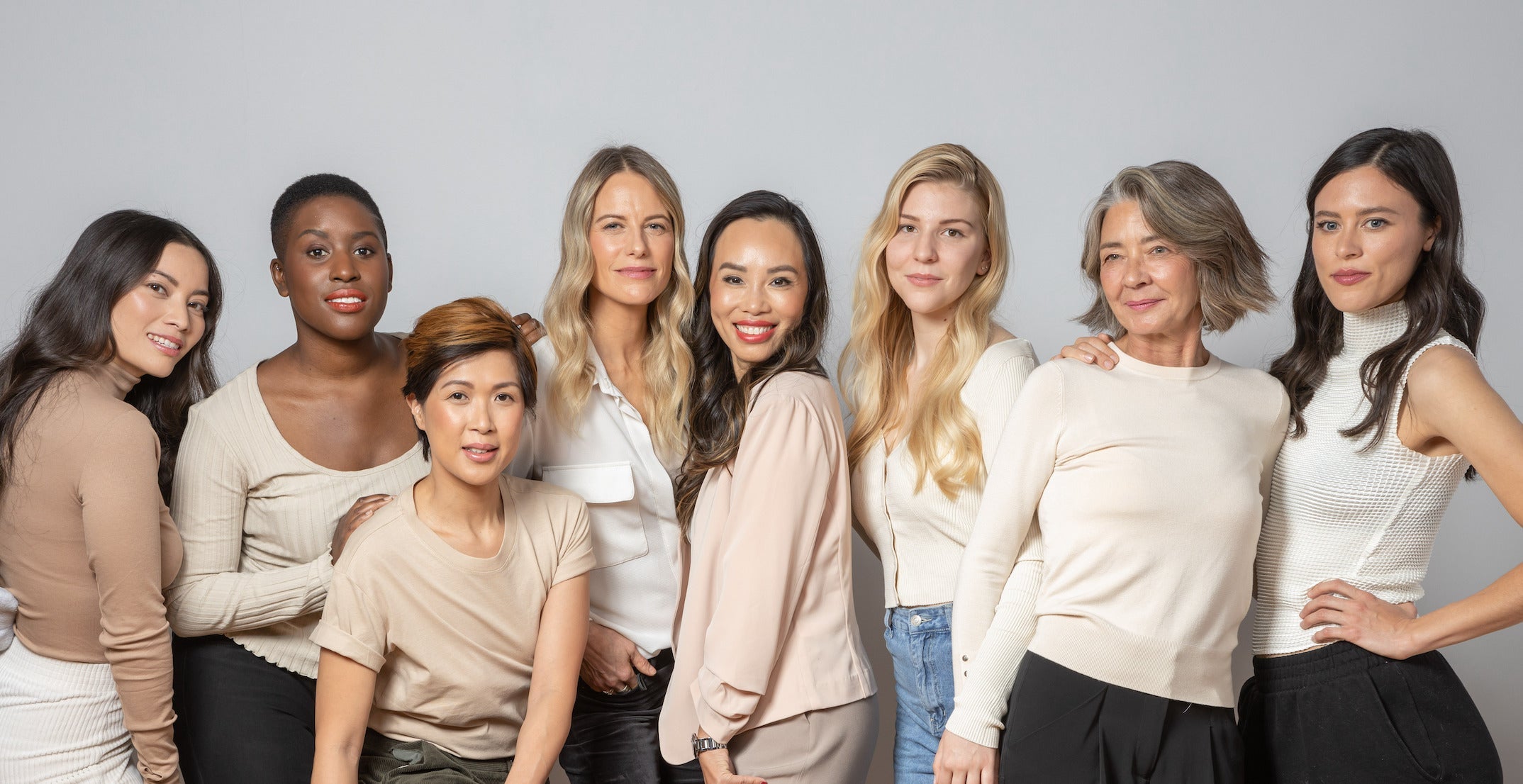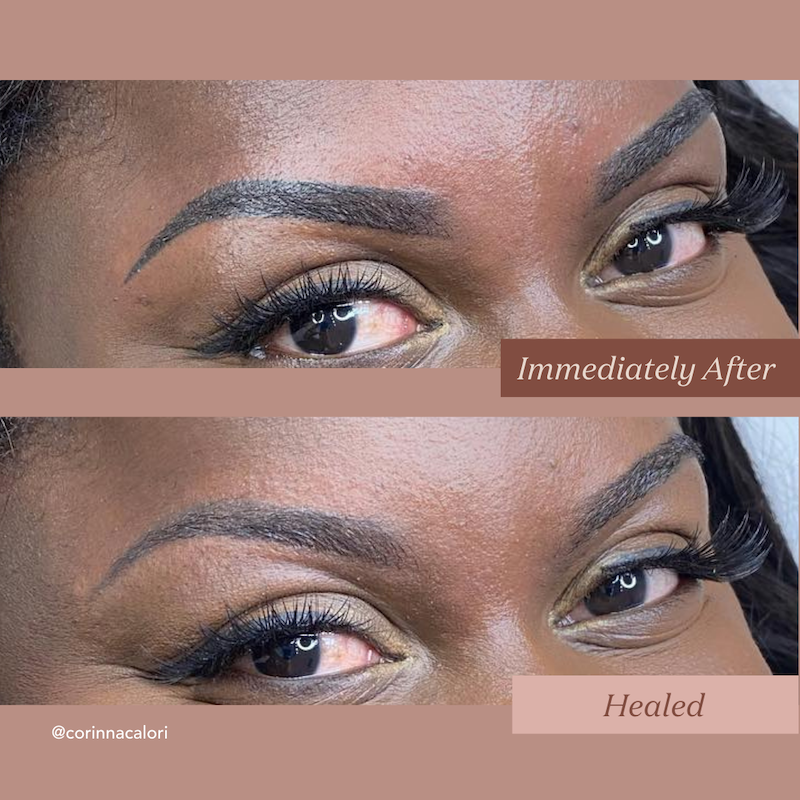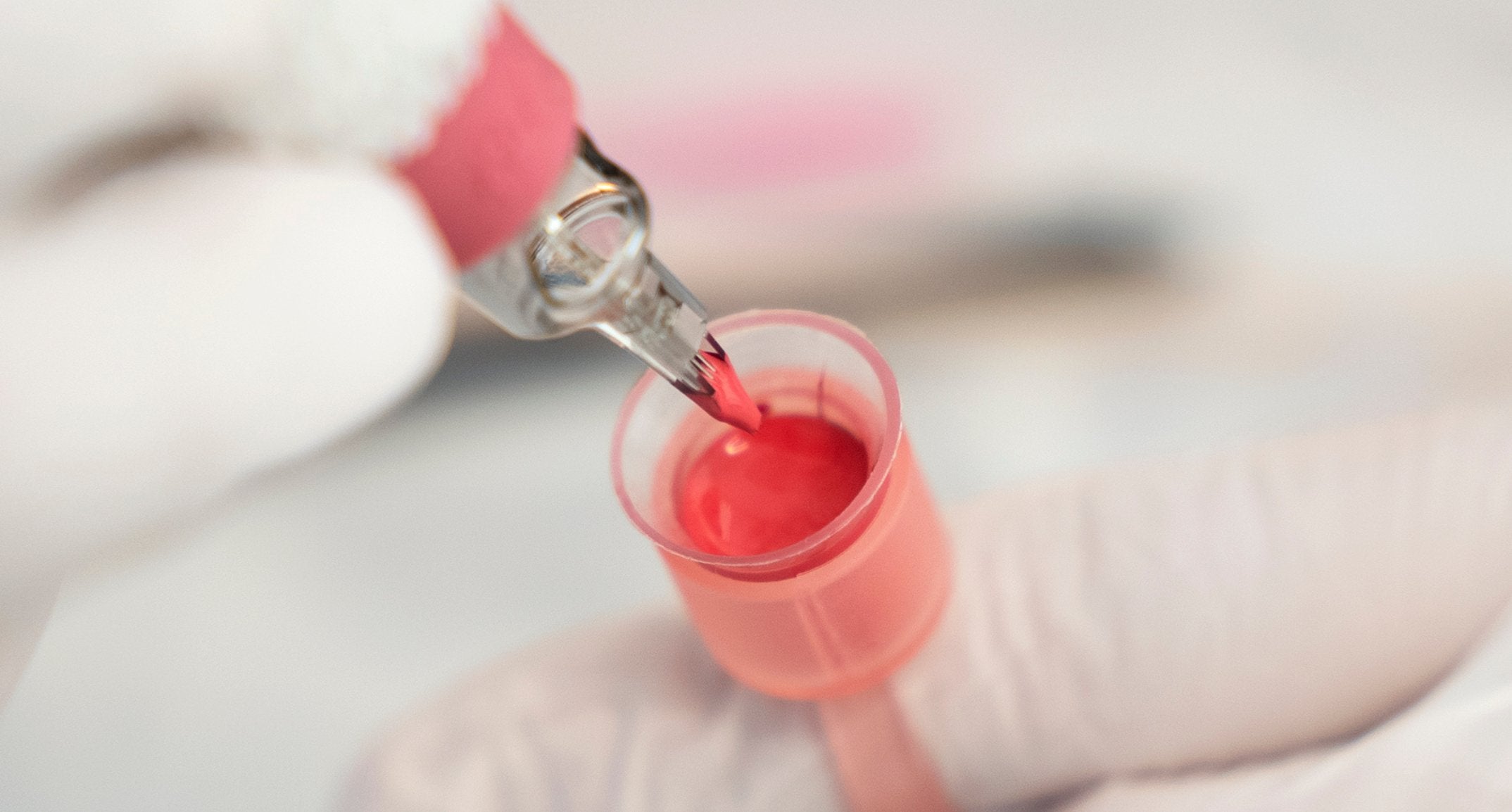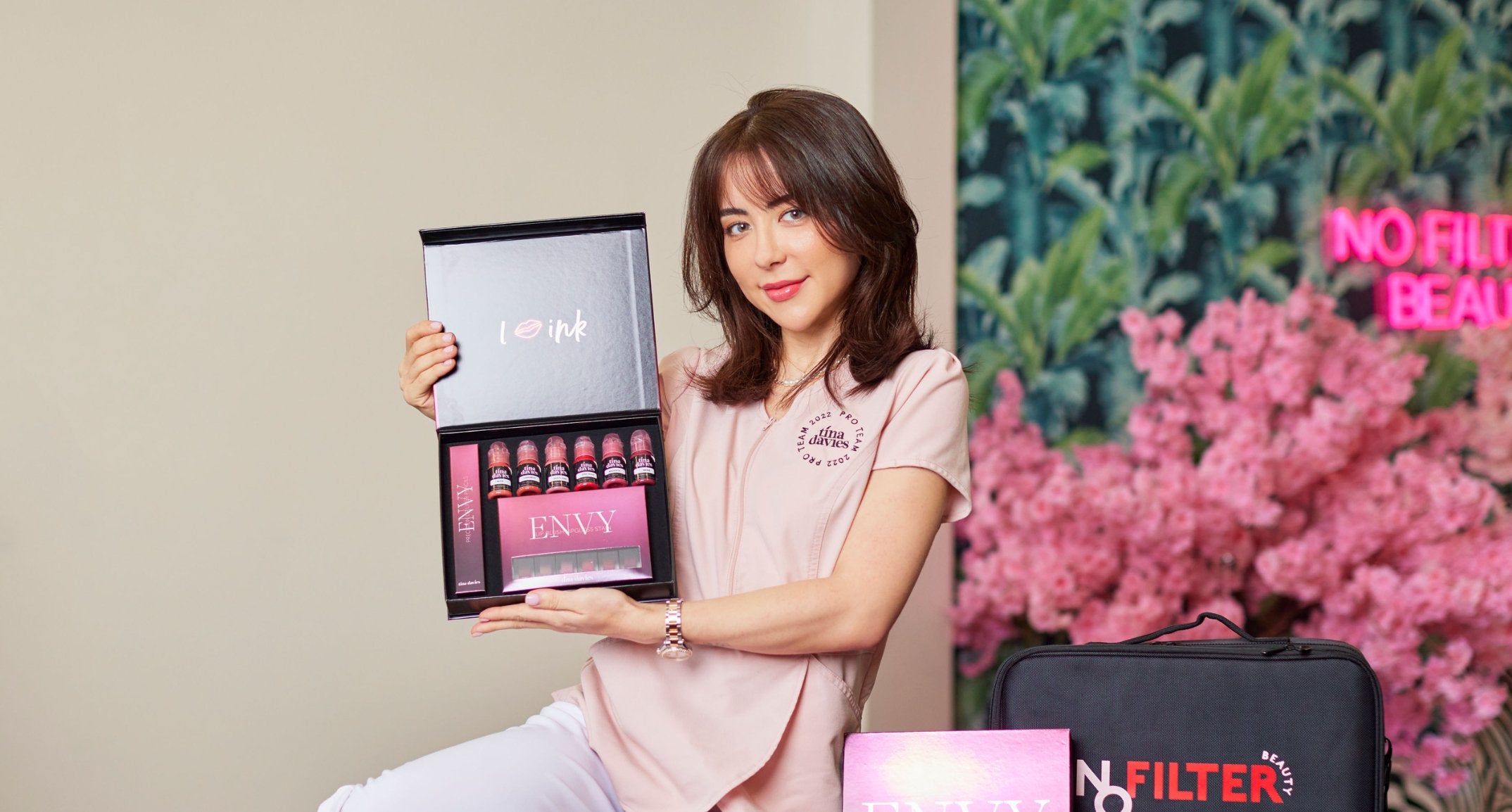
How To Choose I ❤️ INK Colors For Your Clients + Popular Mixes
Each day as PMU artists, we get to help bring joy and transform our client’s brows from “meh” to “WOW”!
A large part of that fun is designing bespoke looks and customizing colors based on our clients’ needs and our color theory knowledge to create fantastic results that our clients will love.
In this blog post, I will cover:
- The important consideration of the client’s personal preference and lifestyle
- Skin overtones and undertones + the “cooling effect” of pigment
- Celebrity examples and recommendations with I ❤️ INK brow pigment colors
- Healed result examples
- FAQs
When choosing colors for our clients, the most important considerations are:
1. The client’s preference and lifestyle
What type of effect does your client want to achieve? Natural or bold/glam? What is their day-to-day lifestyle? Does your client wear minimal or a lot of makeup on a daily basis for work, events, etc. Do they want to wake up with a barely-there look or do they want a more defined look so they don’t have to add any additional brow makeup? This is really important to determine right off the bat so you can decide how saturated of a look your client wants to achieve. For example, a soft blonde look will be a different pigment choice than a dark blonde look. You can mix and customize colors to create this effect.
To prep for this assessment, have your client arrive at the appointment with their eyebrows with makeup on so you can see exactly how they wear their makeup. If your client doesn't normally fill in their brows, request for them to bring pictures of brows they like. Whether it's from your own work or brow inspiration. It is very important to see pictures of their ideal brows as a picture reference is worth a thousand words. This will help guide you with pigment selection based on the two factors below: SKIN OVERTONE AND UNDERTONE.
2. The client's skin overtones and undertone
Skin overtone refers to the general surface skin color. Skin tone is determined by the amount of melanin (skin pigment) present in the uppermost layer of the skin. While each skin overtone can consist of very different complexions, the four main types of skin tone are:
- Light (fair or pink undertone), Fitzpatrick 1-2
- Medium (beige or olive undertone), Fitzpatrick 3
- Dark (caramel or dark brown undertone), Fitzpatrick skin type 4-5
- Deep (brown/black undertone), Fitzpatrick skin type 6
- Warm
- Neutral
- Cool
Here’s a chart that layouts overtones and undertones with some callouts:
Gwyneth Paltrow has a LIGHT overtone with a WARM undertone
Johnny Depp has a MEDIUM overtone with a NEUTRAL undertone
Zoe Saldaña has a DARK overtone with a COOL undertone
Naomi Campbell has a DEEP overtone with a WARM undertone

An overview of skin overtones and undertones
3. The “cooling effect” that occurs once the skin is healed
Now that you understand that skin tone consists of the overtones and undertones, there is another important factor that greatly affects the healed outcome and that is THE COOLING EFFECT of pigment.
As pigment heals in the skin after the procedure, it will look duller and cooler/ashier (blue/grey) after healing in 30-40 days. You always need to account for this factor with your pigment selection by erring on the side of warm to avoid results that heal too cool/ashy. In short, warm undertoned pigments are your friend to help avoid ashy healed results. This is why artists like to add a few drops of a warm modifier/color into their chosen pigment for that “warm insurance”. This is also why you need to avoid cool pigments on cool skin since it will heal “extra cool” by default of the “cooling effect”.
To summarize:
👉 Client overtone + undertone + chosen pigment(s) + the cooling effect = healed result
Keep these factors in mind when choosing your colors and you’ll be on the right path to great healed results. Remember that your technique greatly affects the healed results so be sure to take good notes to learn from how you approached each of your cases. Sometimes, the color choice can be right but the technique isn’t or vice versa. This will speed up your learning curve as you'll learn what worked and didn’t work from client to client.
One more thing before we move on is “what to expect following a permanent eyebrow treatment”?
👉 The skin may look slightly swollen, red, irritated and bright/warm during the first week after the treatment
If you’ve ever had a tattoo before, you may have seen this already. The skin can start to be irritated and tender as you go through the tattoo process. It’s normal to see redness and swelling as the skin’s wheel-and-flare response to the trauma, especially with clients that have fair, sensitive skin and cooler undertones.
Also, many pigments have warm undertones so it’s normal to see orange and reddish irritated eyebrows after a procedure! Be prepared for this and reassure your client that this will subside after a few days, and warm undertones are necessary for the best long-term healed results.
Pro Tip: Using a cold compress on the skin during or after the procedure can calm the skin and bring down swelling and redness. In addition, using topical anesthetics such as Tag #45 or Ultra Duration containing epinephrine can reduce redness and swelling due to its vasoconstrictor properties.
Here’s a the lineup of all the Tina Davies x Perma Blend I ❤️ INK EYEBROW Colors with reference pictures, color temperatures and values including CI codes for your handy reference.

Getting into it IRL!
Now let’s take a deeper dive with 10 celebrity examples of various skin overtones and undertones to help you make the best pigment choices with the range of Tina Davies I ❤️ INK brow colors.
LIGHT OVERTONE, Fitzpatrick type 1-2
- Highly sensitive white/ivory skin burns easily and never tans when exposed to the sun.
- Usually has a light eye color (blue, grey or green) and frequently has red or blonde hair (however, can have dark hair).
- Skin often has a pink/red/cool undertone.
- Typically from Celtic or Northern/Eastern-European descent. Can be Asian as well.
- When the client's preference is more defined and bold, you can mix lighter pigments with darker ones to deepen them.
- Frequently, a combination of light to medium value pigments with added warmth works best for this type of skin to create a bespoke color that prevents ashy results.
Main color: Blonde
Optional mixing color: Medium Brown

👉 Pro Tip: Add Medium Brown to intensify the color.
Medium Brown is a warm, medium-value pigment with a warm base, resulting in a gorgeous medium, neutral brown color when completely healed. It's’ perfect for your clients that are looking for a neutral, natural eyebrow. This pigment is suitable for your clients with light to medium skin tones.
Main color: Sunset
Optional mixing color: Toffee

👉 Pro Tip: Add a couple of drops of Toffee to deepen it so that heals not too light, not too dark- perfect to complement Emma Stone's firefly locks
Toffee is a warm, medium-value reddish-brown pigment with a warm orange base. It is one shade darker than Sunset. You can use it on its own, to mix, or as a warm modifier for any color.
Main color: Dark Brown
Optional mixing color: Bold Brown

👉 Pro Tip: Add a couple of drops of Bold Brown to deepen Dark Brown needs an “extra punch”.
Bold Brown is a neutral, dark value pigment with a warm base. It’s perfect for clients for a strong, vivid look. It results in a flat dark brown with no warmth. This is a great color to darken any color within the line.
Main color: Grey
Optional mixing color: Blonde

👉 Pro Tip: Add a couple of drops of Blonde to lighten Grey by 1-2 shades, yielding a Taupey-ash grey color.
Blonde is a neutral/warm pigment with a light value and a warm base. This warm pigment is good for light skin, warm to cool-toned clients and results in a light taupe for a natural blonde look.
Main color: Toffee
Optional mixing color: Autumn

Toffee is a warm, medium-value pigment with a warm base. It’s perfect for clients wanting beautiful warm reddish-brown color. Julia’s light skin overtone and neutral undertone make her the ideal candidate for this shade that will heal so complimentary with fiery locks and signature smile.
👉 Pro Tip: Mix with Autumn to deepen the tone and add extra intensity.
Autumn is a warm, dark-value pigment that is ideal for clients that want a warm-brown look to their eyebrows. Use it on its own or as a warm-modifier for any color.
MEDIUM OVERTONE, Fitzpatrick type 3
- Can be sun sensitive and sometimes tans moderately.
- Typically of North American, Asian or Central-European descent.
- Can have warm, neutral or cool undertones.
- Frequently, medium to dark value pigments is best for this type of skin.
- When the client's preference is more defined and bold, you can mix in a few drops of a darker pigment to deepen any color.
#6 Gemma Chan: Medium overtone, neutral to cool undertone, Fitzpatrick 3
Main color: Dark Brown
Optional mixing color: Bold Brown
👉 Pro Tip: Adding a couple of drops of Bold Brown will deepen Dark Brown for that more “defined” look that suits Asian black eyebrow hairs very well.
Bold Brown is a neutral, dark value pigment with a warm orange base. It’s perfect for clients for a strong, vivid look. It results in a flat dark brown with no warmth. This is a great color to darken any color within the line.
#7 Johnny Depp: Medium overtone, neutral undertone, Fitzpatrick 3
Main color: Ash Brown
Optional mixing color: Bold Brown

Ash Brown is a neutral-cool, medium-value pigment with a warm base. It is ideal for clients looking for an ash-based eyebrow. Johnny’s medium overtone and neutral undertone make him the ideal candidate for this shade.
👉 Pro Tip: Add a couple of drops of Bold Brown to create more intensity for that more “defined” look.
Bold Brown is a neutral, dark value pigment with a warm base. It’s perfect for clients for a strong, vivid look. It results in a flat dark brown with no warmth. This is a great color to darken any color within the line.
DARK OVERTONE, Fitzpatrick type 4-5
- Minimally sun-sensitive skin, rarely burns, always tans to moderate brown.
- Skin color before sun exposure is usually golden, olive or light brown.
- Usually has dark brown eyes and dark brown hair.
- Typically of Asian, Middle-Eastern, or African descent.
- This skin type generally needs pigments with rich or intense dark browns and hints of black.
- Depending on the client’s hair color, eyebrow preferences and lifestyle, choose a dark brown or a neutral dark brown.
#8 Beyoncé: Dark overtone, warm undertone, Fitzpatrick 4-5
Main color: Dark Brown
Optional mixing color: Bold Brown

👉 Pro Tip: Adding a couple of drops of Bold Brown will deepen Dark Brown for that more “defined” look.
Bold Brown is a neutral, dark value pigment with a warm base. It’s perfect for clients who have a dark overtone and looking for a bolder, stronger look. It results in a flat dark brown with no warmth, making this the ideal shade for someone like Beyoncé who has dark overtones and warm undertones.
#9 Zoe Saldaña: Dark overtone, cool undertone, Fitzpatrick 5
Main color: Bold Brown
Optional mixing color: Autumn to modify

👉 Pro Tip: Add a couple of drops of Autumn to warm Bold Brown to combat Zoe’s cool undertone to avoid an ashy healed result acting as “warm insurance”.
Autumn is a warm, dark-value pigment that is ideal for clients that want a warm-brown look to their eyebrow or as a modifier for your dark-toned pigments.
DEEP OVERTONE, Fitzpatrick 6
- Minimally sun-sensitive skin, rarely burns, always tans.
- Skin color before sun exposure is usually dark golden to cool black.
- Usually has dark brown eyes and black hair.
- Typically of African descent.
- Depending on the client’s hair color, eyebrow preferences and lifestyle, choose the deepest value pigments to give contrast against their deep skin overtones.
Color options: Bold Brown/Ebony

👉 Pro Tip: Mix with Ebony to create deeper contrast against the skin’s overtone.
Ebony is a cool, dark-value pigment. It’s perfect for clients with dark overtones that need maximum impact and contrast against the skin. Due to its coolness, Ebony will naturally ash out, so use sparingly to avoid over-saturating and creating very flat and cool results.
#11 Lupita N’yongo: Dark overtone, cool undertone, Fitzpatrick 6
Color options: Ebony

👉 Pro Tip: Due to Lupita’s cool undertone, maximum depth of color will be required against her deep overtone. Ebony can be modified (warmed up) with a pure orange pigment such as Evenflo Neutralizer that contains no Titanium Dioxide (CI 77891) to prevent cool results.
Note: When warming up/modifying colors, using pigments that are light to mid-value containing Titanium Dioxide (CI 7789) will lighten any color due to the inclusion of white. However, if you use an orange pigment that has no Titanium Dioxide such as Evenflo Neutralizer, it will not lighten the color, only shift the temperature of the color warmer.
The Special Cases - Rainbow-Colored Hair
Regardless of skin overtone, many clients nowadays are adventurous with their hair looks and often arrive at our studio with blue, red or green hair! Some of your clients with colorful hair may request eyebrows to match. However, we strongly recommend that you encourage your client to choose a shade that matches their natural eyebrow color. Remind them that they may not be a red-head, mermaid queen or unicorn princess forever!
Healed Results


 Healed Ebony
Healed Ebony

PIGMENT FAQ’s
Q: Are the Tina Davies I ❤️ INK pigments organic or inorganic?
A: This is a hybrid pigment line that is comprised of both organic and inorganic pigments to provide vibrancy and longevity. You can reference the color chart above to view the CI #’s and view our MSDS here.
Q: Can I mix these colors with another color to create a custom blend and modify?
A: Yes, you can absolutely mix your color with Tina Davies colors or other Perma Blend colors. It is important that you understand the base undertones of the colors you are mixing so you can predict the outcome based on PMU color theory. Do not mix with other brands outside of Perma Blend as undesired and unpredictable results may occur.
Q: How many passes should I make?
A: I ❤️ INK pigments are very concentrated to achieve high saturation so it is considered a “high coverage” pigment range. It is important not to oversaturate the skin as it has an extremely high retention rate of approximately 80-90% that may look to bold and solid. For the best results, you should aim for a semi-transparent saturation with plenty of space between passes and pixels to avoid that “tattooed” look. Think “light and airy” vs. “dark and solid”. Remember, you can always add more when your client returns.
Pro Tip: Dilute your pigments with Shading Solution to create sheer washes of the pigment without over-saturating. You can have the dilutions prepared on your workstation so they are ready in arm’s reach.
Q: I heard that Perma Blend pigments last forever and barely fade. How long should I expect the color to stick around?
A: The colors will last for several years and will never fully fade away due to the concentrated formulation of high-quality organic and inorganic pigments. Due to its concentration, do not oversaturate the pigment as it can lead to dense and flat results. Tattoo to the desired saturation and stop. Wait to see results after 6 weeks before adding more pigment. You can dilute the pigments with 30-70% of Tina Davies Shading Solution to lessen the concentration of the pigments. This is especially important for mature clients who tend to have very thin or sensitive skin that “grabs” color easily.
Q: When should I ask my client to return for color maintenance?
A: Clients should maintain their brows every 2 to 3 years to check the results of fading and make any adjustments to shape or color accordingly. Over time, these pigments tend to fade and cool down, losing their original vibrance yet still maintaining their shape. At this point, using a warm color will breathe warm undertones back in the faded, cool brown pigment. For example, if the color Ash Brown or Bold Brown has faded to a greyish mid to deep value color, use a warm pigment such as Perma Blend’s modifier Gourd Toner or Evenflo Neutralizer to “warm up the color”, canceling out the grey tones. Always modify and view the healed results first before applying a dark target color as just the step of warming will often be enough! The use of a modifier without Titanium Dioxide such as Evenflo Neutralizer can be repeated every 2-3 years to refresh the brows.
Q: What is the difference between Tina Davies Pigments and Perma Blend’s current line?
A: Perma Blend is our manufacturer and we’ve partnered with them to keep color selection simple and straightforward with a range of colors to suit all of your clients in 10 warm-to-cool and light-to-dark pigments. You can mix or modify the colors to create custom-blended results for your clients. Also, each set includes an easy-to-use color chart for quick reference and easy color selection. Perma Blend also has a wide array of different colors, modifiers, and toners that will round out any artist’s needs.
Q: Can these pigments be used for microblading AND machine work?
A: Yes, these pigments can be used for BOTH microblading and machine work.
Q: When tattooing either by machine or microblade, the color doesn’t seem to be implanting or appearing on the skin. What is the issue?
A: The most common cause of this issue is working too fast and failing to implant into the upper dermis layer of the skin where the pigment becomes permanent. Our pigments are thinner than most so if you are newer to the line, there may be a slight learning curve. Slow down and be very deliberate and intentional with your pigment deposit vs. moving fast and brisk.
I cannot express how important it is to work slowly and clean. If you are having trouble with the pigment implanting into the skin, please make sure you wait for the pigment to slide down and “drop” from the needle and make contact with the skin before proceeding. We have found this technique helps many artists when first working with a thinner consistency pigment. This ensures that you are grabbing and placing the pigment into the upper dermal layer of skin effectively. Please remember to also work very clean with a firm taut stretch (the most underrated technique in PMU). Frequently wipe your blade or needle tip to ensure that the pigment is not drying and clogging your needle.
Check out our best tips here:
Machine Tips
Microblading Tips
Q: Can I cover old faded PMU with these colors? If so, how?
A: Old PMU should be faded by a minimum of 50% in order to cover up the original PMU successfully. The residual undertone of the remaining pigment should be factored into the final pigment color choice especially when a color correction is needed.
For example, if the color Ash Brown or Bold Brown has faded to a greyish mid to deep value color, use a warm pigment such as Perma Blend’s modifier Gourd Toner or Evenflo Neutralizer to “warm up the color”, canceling out the grey tones.
Always modify and view the healed results of the modifiers first before applying a dark target color as just the step of warming will often be enough! The use of a modifier without Titanium Dioxide such as Evenflo Neutralizer can be repeated every 2-3 years to refresh the brows.
If the old color is still very saturated and dense, removal by saline or laser is highly suggested to “lift out the heavy saturation” in order to achieve the best results.
Q: The color seems to dry very fast on the skin during the masking step of microblading. How do I remove it easily?
A: If you are finding the pigment dries fast, you can place a piece of saran wrap over the eyebrows when you are masking, as this will help keep the pigments moist and easy to wipe off. Ensure you're wiping your blade or machine throughout your procedure to prevent the pigment from drying on the tool.
To remove dried pigment, take a wet cotton pad soaked in a diluted soap mixture and place it over the eyebrow for a few seconds. This will make the pigment wet again. After a few seconds, just give the cotton pad a wiggle wipe and the pigment will come off! Here is a great video for reference.

Pro Tip: Use 1 part of Dr. Bronner’s Baby Unscented Castile Soap to 9 parts distilled water. Your mixture should be 10% soap to 90% distilled water. Put it in a squeeze/wash bottle and squeeze onto soft cotton pads to wipe. Do not use too much soap in your mixture or it will be foamy.
Q: Certain colors look orange/red when I finish the procedure. Should I be concerned? What should I tell my client?
A: Two things could be happening here-
The pigment is not saturated enough, thus the warm undertones of the color are still showing through. More layers/deposit of the color is needed.
If the color is properly saturated, realize that the skin is a bit injured and red. Also, the warm undertones of these colors are present on the skin. This effect subsides after the first 10 days. Prepare your client to expect this look so they are not surprised by this temporary effect. You can read more about this in our blog post here.
When your client returns and the color is still weak, orange or reddish, this is due to lack of saturation and you’ll need to re-do the brows once more to reach proper depth.
I hope you learned a lot and were able to unlock valuable color knowledge and gain confidence in your pigment selection. Stay tuned next month as we dive deeper into colors and pigments!




6 comments
Thank you for providing me with such helpful information. I hope you will continue to offer these valuable contributions to customers. Thank you.
Kathy V
Love,Love this information as a new artist I really appreciate all the valuable information I can get from an amazing artist like Tina Davies. I would love more information on her Scalp and Paramedical color lines. If someone can guide me on how to find detailed information like this that would be much appreciated.
Staci Kroff
Excellent information. Easy to understand, links super helpful. Thank you for this FREE valuable resource!!
Arleen
thank you so so much .
this was very informative and helpful.
perfect chart for colours and healed results.
thanks again.
sapna
Amazing information!!! Absolutely appreciate you posting this! Helped me choose my shades!
Krystal Gravel
Thanks for putting your time and effort to write such a informative post.
You guys team is absolutely wonderful people.
Thanh Phan
Leave a comment
This site is protected by hCaptcha and the hCaptcha Privacy Policy and Terms of Service apply.